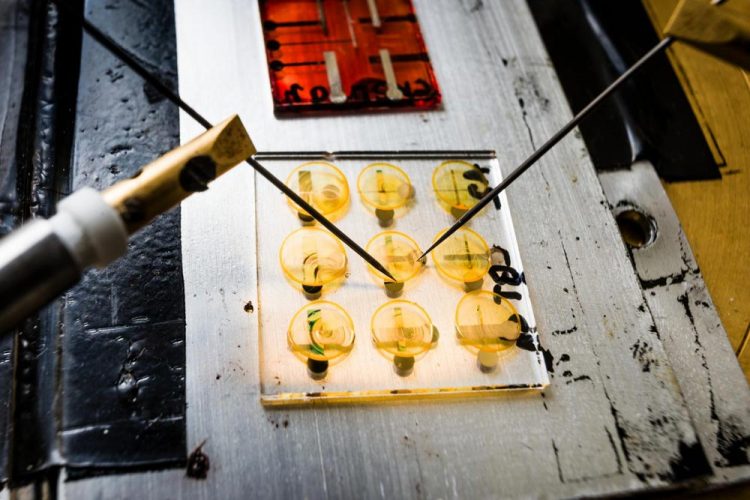New material for digital memories of the future

This is the first material with conductivity properties that can be switched on and off using ferroelectric polarization. Credit: Thor Balkhed
Professor Martijn Kemerink of Linköping University has worked with colleagues in Spain and the Netherlands to develop the first material with conductivity properties that can be switched on and off using ferroelectric polarisation.
The phenomenon can be used for small and flexible digital memories of the future, and for completely new types of solar cells.
In an article published in the prestigious scientific journal Science Advances, the research group shows the phenomenon in action in three specially built molecules, and proposes a model for how it works.
“I originally had the idea many years ago, and then I just happened to meet Professor David González-Rodríguez, from the Universidad Autónoma de Madrid, who had constructed a molecule of exactly the type we were looking for,” says Martijn Kemerink.
The organic molecules that the researchers have built conduct electricity and contain dipoles. A dipole has one end with a positive charge and one with a negative charge, and changes its orientation (switches) depending on the voltage applied to it. In a thin film of the newly developed molecules, all the dipoles can be caused to switch at exactly the same time, which means that the film changes its polarisation.
The property is known as ferroelectricity. In this case, it also leads to a change in the conductivity, from low to high or vice versa. When an electrical field with the opposite polarity is applied, the dipoles again switch direction. The polarisation changes, as does the ability to conduct current.
The molecules designed according to the model developed by the LiU researchers tend to spontaneously place themselves on top of each other to form a stack or a supramolecular wire, with a diameter of just a few nanometres. These wires can subsequently be placed into a matrix in which each junction constitutes one bit of information. This will make it possible in the future to construct extremely small digital memories with very high information density. The synthesis of the new molecules is, however, still too complicated for practical use.
“We have developed a model for how the phenomenon arises in principle, and we have shown experimentally that it works for three different molecules. We now need to continue work to build molecules that can be used in practical applications,” says Professor Martijn Kemerink, from Complex Materials and Devices at Linköping University, and principal author of the article.
###
The article: Ferroelectric self-assembled molecular materials showing both rectifying and switchable conductivity, Andrey V. Gorbunov, Miguel Garcia Iglesias, Julia Guilleme, Tim D. Cornelissen, W. S. Christian Roelofs, Tomas Torres, David Gonza?lez-Rodri?guez,
E. W. Meijer and Martijn Kemerink. Science Advances 2017
DOI 10.1126/sciadv.1701017
Contact
Professor Martijn Kemerink
martijn.kemerink@liu.se
+46 13 28 18 75
Media Contact
All latest news from the category: Materials Sciences
Materials management deals with the research, development, manufacturing and processing of raw and industrial materials. Key aspects here are biological and medical issues, which play an increasingly important role in this field.
innovations-report offers in-depth articles related to the development and application of materials and the structure and properties of new materials.
Newest articles

Durable, Efficient, Sustainable: The Rise of Cerium Oxide Thermal Switches
Groundbreaking cerium oxide-based thermal switches achieve remarkable performance, transforming heat flow control with sustainable and efficient technology. Cerium Oxide-Based Thermal Switches Revolutionize Heat Flow Control Thermal switches, which electrically control…

How Industrial Robots are Reducing Emissions in Global Manufacturing
A new study explores the intersection of industrial automation and environmental sustainability, focusing on the role of industrial robots in reducing the carbon intensity of manufacturing exports. The research demonstrates…

Patients Can Heal Through Precise, Personalized Bioceramic Grafts
A recent review is transforming the landscape of craniomaxillofacial bone regeneration with the introduction of personalized bioceramic grafts. This pioneering research explores the fabrication and clinical potential of synthetic grafts…



